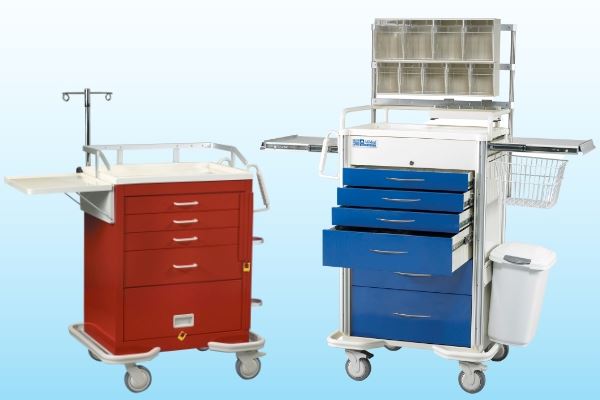-
Home
-
The Importance of Regular Medical Cart Inspections
The Importance of Regular Medical Cart Inspections
June 29, 2023

Medical carts are essential in healthcare settings, from hospitals and surgical centers to outpatient clinics and nursing homes. They provide quick and secure access to medical supplies for various procedures and often include life-saving equipment for medical emergencies.
Whether using a crash cart for a cardiac event, an anesthesia cart for a surgical procedure, or an isolation cart for quarantined areas, every cart plays a crucial role in ensuring the timely response and effective treatment of patients in any setting. Therefore, it’s vital that facilities conduct regular medical cart inspections to make sure carts are functioning properly for safe and effective use whenever or wherever they are needed.
This article will explore common issues to look for during an inspection and best practices for keeping carts in tiptop shape.
What to Look for When Inspecting Medical Carts
Medical carts are typically made of durable steel or aluminum construction. They are equipped with sliding drawers to organize supplies and swivel casters for maneuverability around corners or in congested hallways. Many feature bumpers to help stabilize the cart and safeguard against collisions with walls or other objects.
Although medical carts are designed to withstand the rigors of any hospital or clinical setting, like most medical devices, they are still prone to wear and tear – especially in high-pressure or chaotic settings. This can compromise their functionality and pose safety risks to medical professionals and patients. Common issues to look for may include:
- Malfunctioning equipment or accessories
- Broken or damaged locks or drawers
- Broken, non-functional, or flat casters
- Missing, expired, or contaminated supplies
- Use of non-standard medical equipment
- Use of make-shift or non-standard locking mechanisms, i.e., tape
Regular inspections can help identify and prevent issues that, when left unchecked, could lead to more serious consequences when a cart is needed most.
How to Maintain Medical Carts for Long-Term Effectiveness
Due to their frequent use, medical carts require ongoing maintenance and upkeep. Conducting inspections and maintenance checks not only help to preserve and maintain a cart’s effectiveness, but they can also protect your investment and prolong the lifespan of the cart. Regular maintenance checks help ensure that:
- Casters are free of any debris and swivel properly
- Brake levers are tested and operational
- Locking mechanisms, combinations, or key cards work as expected
- Drawers slide easily and are properly affixed to tracks
- All components and accessories are securely mounted
- Supplies are restocked and properly organized
Carts should also be kept clean and sanitized regularly with approved disinfectants to prevent the buildup of dirt, dust, and bacteria that can compromise the quality and safety of medical supplies.
Inspections should be scheduled based on the cart's usage and the specific requirements of the healthcare facility. In general, carts should be inspected thoroughly every six months and inventoried once a month to ensure optimal maneuverability, accessibility of contents, and overall safety.
Checking Medical Carts for Essential Supplies
Medical carts provide easy access to essential medical supplies such as medications, IV fluids, defibrillators, emergency airways, and oxygen tanks, among others. These supplies must be continuously replenished, and their expiration dates should be monitored to ensure their efficacy and safety.
Carts must be checked and inventoried regularly to ensure that they contain all the necessary supplies required for emergency or other settings. Additionally, medical professionals should be trained to use medical carts efficiently and effectively to reduce response times and improve patient outcomes.
The Joint Commission recommends a “risk assessment” for medical carts to identify any areas of risk and steps to mitigate them. In addition to scheduled inspections, developing procedures and processes for proper cart usage, storage locations for easy access, and how to restock supplies are all essential to ensuring carts are ready to handle their next emergency.
Who is Responsible for Medical Cart Inspections?
The responsibility for medical cart inspections typically lies with the facilities management or biomedical department. However, nurses and doctors who use the carts regularly must report any abnormalities and malfunctioning carts to the appropriate department immediately. In most cases, dedicated professionals oversee the maintenance and inspection of carts to ensure that they comply with healthcare regulations and standards. These professionals have the expertise and resources to conduct regular inspections, diagnose any defects or damages, and repair or replace parts as needed.
Medical carts are some of the most important tools in healthcare settings, providing quick access to essential medical supplies and equipment. However, they are subject to damage that can compromise their quality and functionality. Implementing a regular medical cart inspection plan along with proper staff training and education is crucial to maintaining their effectiveness and ensuring your facility is prepared for any situation. Medical cart inspections are not only a best practice, they are an essential part of every healthcare facilities' responsibility to their patients.